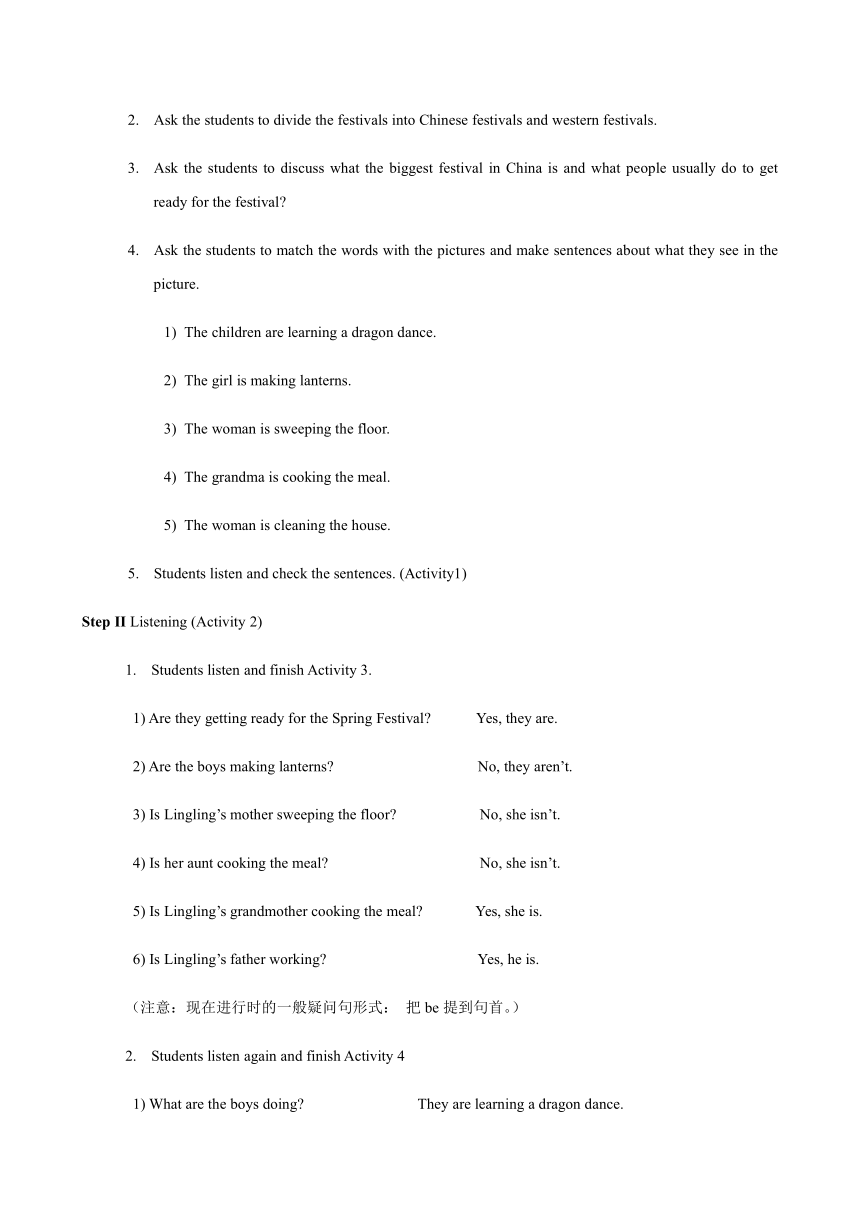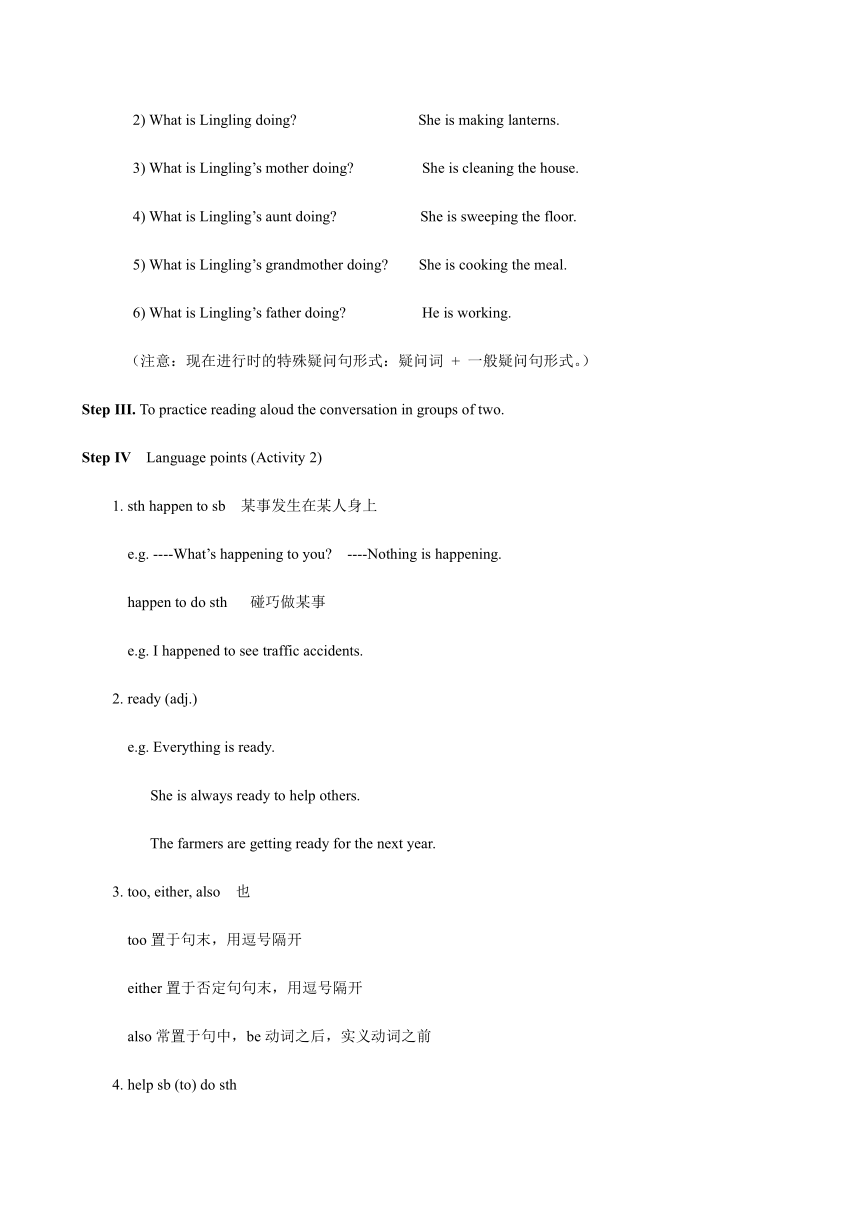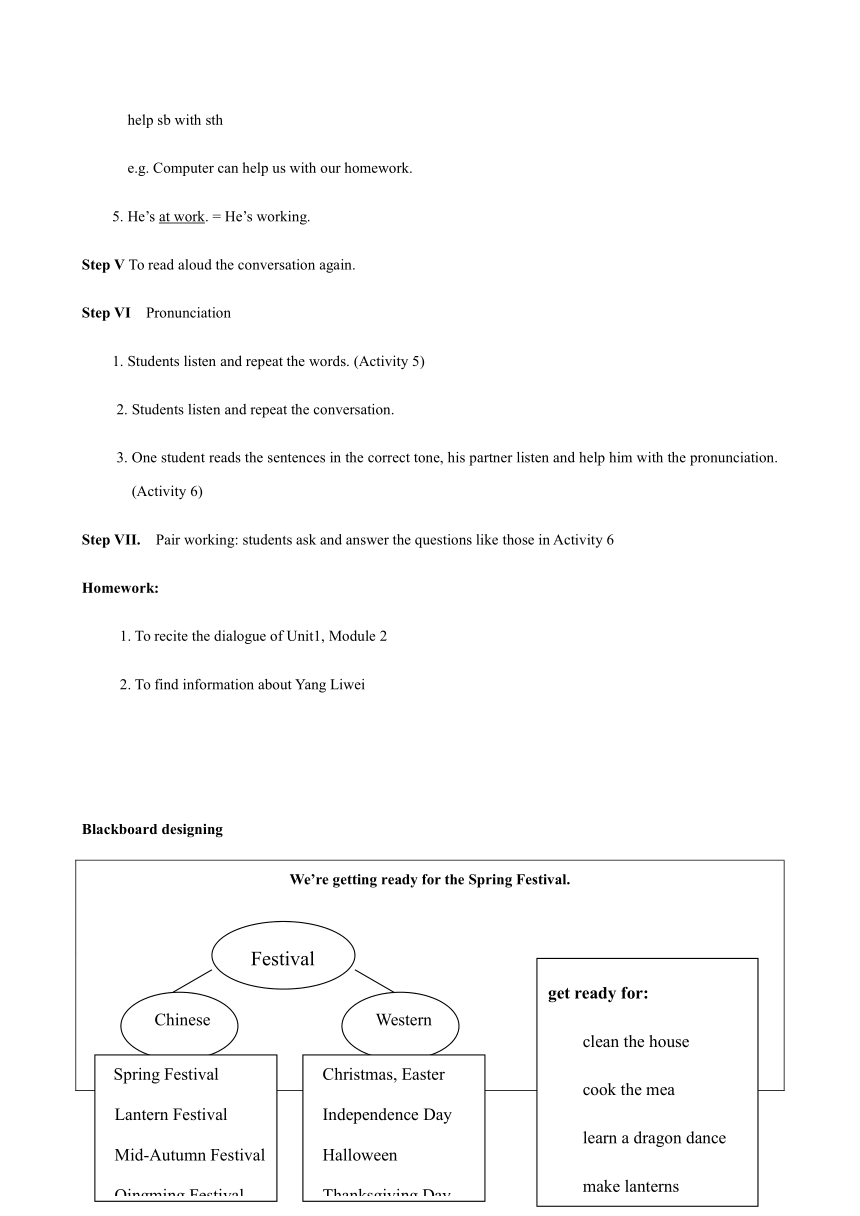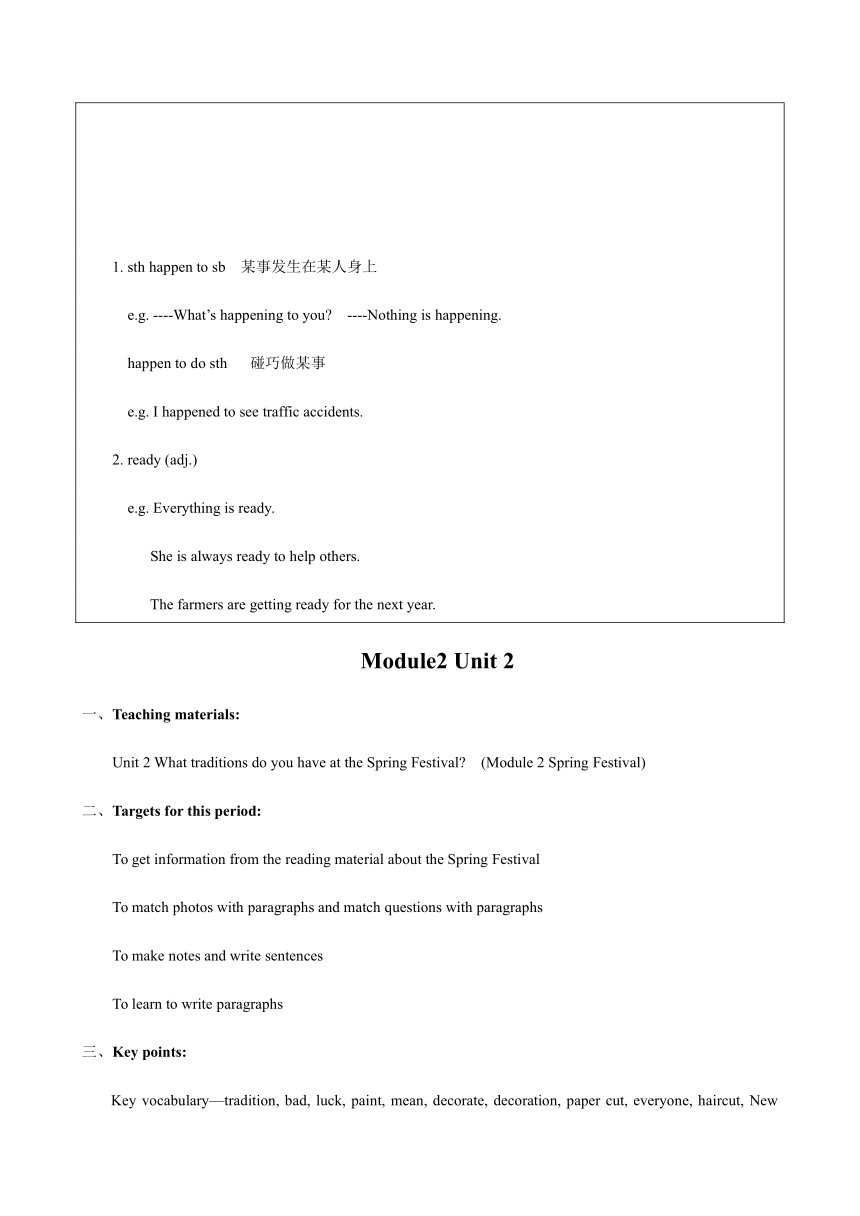外研版英语七年级下册:Module 2 What can you do ? Unit 1 I can play the piano 教案(3课时)
文档属性
| 名称 | 外研版英语七年级下册:Module 2 What can you do ? Unit 1 I can play the piano 教案(3课时) |  | |
| 格式 | zip | ||
| 文件大小 | 76.0KB | ||
| 资源类型 | 教案 | ||
| 版本资源 | 外研版 | ||
| 科目 | 英语 | ||
| 更新时间 | 2020-04-14 18:37:37 | ||
图片预览





文档简介
Module2 Unit 1
一、Teaching materials:
Unit 1 We’re getting ready for the Spring Festival (Module 2 Spring Festival)
二、Targets for this period:
To understand conversations about the Spring Festival
To recognize phrases and recognize short answers in the listening
To talk about the Spring Festival with given information
三、Key points:
Key vocabulary—festival, spring Festival, ready, get ready for, cook, meal, dragon, lantern, dragon dance, Lantern Festival, sweep, sweep away, floor
Key structures—What is Lingling doing?
She’s getting ready for the Spring Festival.
Is your mother working?
Yes, she is.
四、Teaching methods:
Interactive approach
五、Teaching aids
Tape recorder, blackboard
六、Teaching arrangements:
Step I. Warming-up
1. Ask the students to talk about some festivals they know.
2. Ask the students to divide the festivals into Chinese festivals and western festivals.
3. Ask the students to discuss what the biggest festival in China is and what people usually do to get ready for the festival?
4. Ask the students to match the words with the pictures and make sentences about what they see in the picture.
1) The children are learning a dragon dance.
2) The girl is making lanterns.
3) The woman is sweeping the floor.
4) The grandma is cooking the meal.
5) The woman is cleaning the house.
5. Students listen and check the sentences. (Activity1)
Step II Listening (Activity 2)
1. Students listen and finish Activity 3.
1) Are they getting ready for the Spring Festival? Yes, they are.
2) Are the boys making lanterns? No, they aren’t.
3) Is Lingling’s mother sweeping the floor? No, she isn’t.
4) Is her aunt cooking the meal? No, she isn’t.
5) Is Lingling’s grandmother cooking the meal? Yes, she is.
6) Is Lingling’s father working? Yes, he is.
(注意:现在进行时的一般疑问句形式: 把be提到句首。)
2. Students listen again and finish Activity 4
1) What are the boys doing? They are learning a dragon dance.
2) What is Lingling doing? She is making lanterns.
3) What is Lingling’s mother doing? She is cleaning the house.
4) What is Lingling’s aunt doing? She is sweeping the floor.
5) What is Lingling’s grandmother doing? She is cooking the meal.
6) What is Lingling’s father doing? He is working.
(注意:现在进行时的特殊疑问句形式:疑问词 + 一般疑问句形式。)
Step III. To practice reading aloud the conversation in groups of two.
Step IV Language points (Activity 2)
1. sth happen to sb 某事发生在某人身上
e.g. ----What’s happening to you? ----Nothing is happening.
happen to do sth 碰巧做某事
e.g. I happened to see traffic accidents.
2. ready (adj.)
e.g. Everything is ready.
She is always ready to help others.
The farmers are getting ready for the next year.
3. too, either, also 也
too置于句末,用逗号隔开
either置于否定句句末,用逗号隔开
also常置于句中,be动词之后,实义动词之前
4. help sb (to) do sth
help sb with sth
e.g. Computer can help us with our homework.
5. He’s at work. = He’s working.
Step V To read aloud the conversation again.
Step VI Pronunciation
1. Students listen and repeat the words. (Activity 5)
2. Students listen and repeat the conversation.
3. One student reads the sentences in the correct tone, his partner listen and help him with the pronunciation. (Activity 6)
Step VII. Pair working: students ask and answer the questions like those in Activity 6
Homework:
1. To recite the dialogue of Unit1, Module 2
2. To find information about Yang Liwei
Blackboard designing
We’re getting ready for the Spring Festival.
1. sth happen to sb 某事发生在某人身上
e.g. ----What’s happening to you? ----Nothing is happening.
happen to do sth 碰巧做某事
e.g. I happened to see traffic accidents.
2. ready (adj.)
e.g. Everything is ready.
She is always ready to help others.
The farmers are getting ready for the next year.
Module2 Unit 2
一、Teaching materials:
Unit 2 What traditions do you have at the Spring Festival? (Module 2 Spring Festival)
二、Targets for this period:
To get information from the reading material about the Spring Festival
To match photos with paragraphs and match questions with paragraphs
To make notes and write sentences
To learn to write paragraphs
三、Key points:
Key vocabulary—tradition, bad, luck, paint, mean, decorate, decoration, paper cut, everyone, haircut, New Year, New Year’s Eve, dumpling, sweet pudding, fireworks, few, a few, week, round, all the year round, bring, color, something, cut, Christmas
四、Teaching methods:
Task-based approach and interactive approach
五、Teaching aids
Reading material, blackboard
六、Teaching arrangements:
Step I Lead-in: discussion in groups
1. Do you like the Spring Festival? Why?
2. Before the Spring Festival, what do people do? Why?
3. What do people do on the Eve of the Spring Festival?
4. What presents do people get?
5. When does the Spring Festival finish?
Step II To pronounce some new words and expressions of Unit 2
3. Students read the words after the tape.
4. Students practice pronouncing the words by themselves.
5. To help some students correct the pronunciations of some words.
Step III Pre-reading (Activity 1& 3)
1. Students look at the picture2 and match them with the questions in Activity 3
Picture 1: What traditions do you have at the Spring Festival?
Picture 2: What do you do on Spring Festival’s Eve?
Picture 3: When does the spring Festival finish?
Picture 4: What do you do in the Spring Festival?
2. Students try to answer the questions according to the pictures.
Picture 1: We decorate the doors and windows with paper cuts.
Picture 2: We have a rich meal.
Picture 3: It finishes at the Lantern Festival.
Picture 4: We get presents from adults.
Step IV To read the passengers quickly and match the questions with the paragraphs (Activity 3)
A-What traditions do you have at the Spring Festival?
B- What do you do in the Spring Festival?
C- What do you do on Spring Festival’s Eve?
D- When does the spring Festival finish?
Step V To read it again and check the answers to the questions
A: clean our houses, sweep away bad luck, paint doors and windows red, decorate the doors and windows with paper cuts, buy clothes, have a haircut
B: give us New Year presents, put on our new clothes, visit our family and friends, watch dragon and lion dancing
C: have dinner, eat jiaozi or sweet rice pudding, watch TV at midnight, watch fireworks
D: at the Lantern Festival after two weeks, eat yuanxiao
Step VI Language points
1. sweep 打扫
e.g. Please sweep the house clean.
sweep away 扫除
e.g. The wind sweeps away the leaves.
2. paint 画(油画);涂
e.g. He is painting a picture.
Please pain the wall white.
3. mean 意思是,意味着
e.g. ----What do you mean? ----I mean you’re right.
4. decorate 装饰
e.g. They’re decorating their new house with flowers.
5. family
e.g. My family has a rich meal.(全家人,强调整体)
Our family are going on a trip.(全家人,强调成员)
Many families decorate their house with colored lights.(家庭,强调社会单位)
6. all the year round 全年
e.g. They work hard all the year round.
Step VII Students practice reading the passage aloud
Step VIII Students discuss the questions in groups (Activity 4)
1. Paper cuts, apples are red.
2. Good luck is happy and good things. Bad luck is sad and bad things.
3. The doors and windows are in the wall.
4. Paper cuts are things that people use scissors and knives to cut shapes in paper and use them to decorate houses.
5. Decorate means to make things more beautiful.
6. A haircut means to make hair shorter.
7. Dumpling is a kind of food people in North China eat during the Spring Festival.
Sweet rice pudding is a kind of food people in South China eat during the Spring Festival.
8. Midnight is twelve o’clock at night.
9. Fireworks are the show of explosive devices to make smoke, fire and noise for happiness.
Step IX Writing
1. Students use the word map to match the notes with the headings. (Activity 5)
Decorations: d, e, j Food: b, f, h Getting ready: a, d, e, f, j
Presents: a, c, e Traditions: a, b, c, d, e, f, g, h
2. Students join two notes and write one sentence with “and”.(Activity 6)
1) They go shopping for presents and get lots of food ready.
2) They eat Christmas pudding and have Christmas dinner.
3) They say “Happy Christmas” to family and friends and sing Christmas songs.
4) They decorate homes and have a Christmas tree.
5) They put the presents next to the Christmas tree and open their presents on Christmas Day..
3. Students put the headings before the sentences.(Activity7)
4. Students write a passenger describing Christmas in Britain.
Homework:
1. To find information about a hero and get ready to give a talk, you can take the module task on P73 for example.
Blackboard designing
Unit 2 What traditions do you have at the Spring Festival?
Spring Festival in China
The beginning of the Spring festival: clean our houses, sweep away bad luck, paint doors and windows red, decorate the doors and windows with paper cuts, buy clothes, have a haircut
On New Year’s day: give us New Year presents, put on our new clothes, visit our family and friends, watch dragon and lion dancing
On New Year’s Eve: have dinner, eat jiaozi or sweet rice pudding, watch TV at midnight, watch fireworks
The end of the Spring Festival: at the Lantern Festival after two weeks, eat yuanxiao
Christmas in Britain
Getting ready for Christmas:
They go shopping for presents and get lots of food ready.
Food:
They eat Christmas pudding and have Christmas dinner.
Traditions:
They say “Happy Christmas” to family and friends and sing Christmas songs.
Decorations:
They decorate homes and have a Christmas tree.
Presents:
They put the presents next to the Christmas tree and open their presents on Christmas Day.
1. sweep 打扫
e.g. Please sweep the house clean.
sweep away 扫除
e.g. The wind sweeps away the leaves.
2. paint 画(油画);涂
e.g. He is painting a picture.
Please pain the wall white.
3. mean 意思是,意味着
e.g. ----What do you mean? ----I mean you’re right.
4. decorate 装饰
e.g. They’re decorating their new house with flowers.
5. family
e.g. My family has a rich meal.(全家人,强调整体)
Our family are going on a trip.(全家人,强调成员)
Many families decorate their house with colored lights.(家庭,强调社会单位)
6. all the year round 全年
e.g. They work hard all the year round.
Module2 Unit 3
一、Teaching materials:
Unit 3 Language in use (Module 3 Spring Festival)
二、Targets for this period:
To consolidate Present continuous questions and short answers
To learn new words by using word map and pictures
To write a letter about the Spring Festival
三、Key points:
Key structures—Are you learning a dragon dance? No, I’m not. I’m making lanterns.
Is your mother cooking? Yes, she is.
四、Teaching methods:
Formal and interactive approach
五、Teaching aids
Blackboard, handouts
六、Teaching arrangements:
Step I Warming-up (Around the world)
1. Students find more information about Christmas by answering the questions
1) What is the most important festival in the western countries? Christmas.
2) What is it to celebrate? The birth of Jesus Christ
3) What is Father Christmas like? A fat man with a long white beard and wears a red suit
4) What does Father Christmas give to the children? Presents
2. Language points
1) celebrate
e.g. How does she celebrate her birthday?
2) be interested in
e.g. He isn’t interested in Mothers’ Day.
3) wear, put on, dress
Wear sth 穿着 / 戴着某物 (强调状态)
Put on sth 穿上 / 戴上某物 (强调动作)
Dress sb 给某人穿衣服
Step II Vocabulary learning (Activity 4)
Students use the word map to write the words and phrases in Units 1&2 under the headings.
Getting ready: clean the house, sweep the floor, paint the doors and windows red, buy clothes, have a haircut, cook the meal, learn the dance, make the lanterns
Decorations: paper cut, lanterns
Food: cake, jiaozi(dumpling), niangao(sweet rice pudding), yuanxiao(rice dumpling)
Presents: new clothes
Traditions: watch fireworks at midnight, visit family and friend, watch dragon and lion dancing
Step III To write short answers according to the example (Activity 1)
Step IV To write questions and short answers (Activity 2)
1. Is Lingling’s mother cleaning the house? Yes, she is.
2. Is Lingling’s father making lanterns? No, he isn’t.
3. Is Lingling’s aunt cooking the meal? No, she isn’t
4. Is Lingling’s grandmother sweeping the floor? No, she isn’t.
5. Are the boys learning a dragon dance? Yes, they are.
6. Are Lingling and her family getting ready for the spring Festival? Yes, they are.
Step V Comparison: 一般现在时和现在进行时的几点不同
一、基本用法不同
1. 一般现在时用来表示习惯性的动作或状态。
如: She goes to school by bike every day.
2. 现在进行时用来表示现在(说话的瞬间)正在发生或进行的动作或者用来表示现阶段正在进行或存在的状态。
如: Look ! She is reading under the tree.
二、谓语动词的形式不同
1. 一般现在时的谓语动词:1) be动词用am/is/are这三种形式;2)实义动词用动词原形或第三人称单数形式(根据主语数的变化而变化)。
如:We go to school at seven in the morning.
2. 现在进行时谓语动词的形式为: am / is / are+动词-ing 形式。
如: I am reading English now. 我现在正在读英语
三、时间状语不同
1. 一般现在时常与often, sometimes, always, usually等频率副词连用,还与 every morning /day / week..., on Wednesday, in the morning / afternoon / evening等时间状语连用。
2. 现在进行时常与now, these days, these weeks等时间状语连用。句首有 Look ! / Listen !等提示语时,后面的句子中动词一般用现在进行时。
四、特殊用法不同
1. 一般现在时的特殊用法: 表示客观真理、自然现象往往要用一般现在时表示。
如: The moon goes round the earth.月亮绕着地球转。
2. 现在进行时的特殊用法: 现在进行时与always 连用时,往往含有赞扬、厌恶、责备等感彩。
如: He is always working hard.他总是非常努力地工作。(表示赞扬)
come, go, begin, start, leave 等动词常用现在进行时表示将要发生的动作。
如: I'm coming. 我就来。
Step VI 用所给词的适当形式填空。
1. It’s six o’clock in the morning. I am getting (get) dressed.
2. Look! Daming is lying (lie) in the sun.
3. Listen! Betty and Lily are singing (sing) an English song.
4. Tony isn’t reading. He is writing (write).
5. What is Wang Hui doing (do) at the moment?
6. Betty’s mother is visiting (visit) Hollywood now.
7. ---Where is Lucy?
---She is shopping (shop) with her mum.
8. We often have (have) lunch at home.
9. He goes (go) to the opera every Sunday.
10.Thank you for sending (send) me a post card.
11.Look! Tom with his classmates is playing (play) football over there.
12.It’s 8:30 in the morning. Is Jim having (have) a Chinese class?
13.Little Bob has (have) a toy boy now.
14.John doesn’t live (not live) with his parents. He shares a room with his friend.
15.Who usually does (do) shopping in your family?
16.-- Does Lily bring (bring) her dictionary every day? –Yes, she’s cooking (cook) now.
17.Don’t drink (drink) too much coke. It’s not good for you.
18.My grandma watches (watch) TV every day. But she isn’t watching (watch) now.
19.Does Betty write (write) to you very often? –No. But I think she is going to write to me soon.
20.-Where does Harry often buy (buy) his train tickets?
Step VII To translate into English
1. 你们正在为春节作准备吗?
Are you getting ready for the Spring Festival?
2. 我们经常用剪纸来装饰门窗。
We often decorate doors and windows with paper cuts.
3. 连续几天,我们不打扫房间,因为我们不想把好运扫走。
We don’t clean the house for a few days, because we don’t want to sweep away good luck.
4. 在新年那一天,我们穿上新衣服去给亲戚朋友拜年。
On New Year’s Day, we put on new clothes and visit our family and friends.
5. 他们给我们一年四季带来好运气。
They bring us good luck all the year round.
6. 红色代表幸运,所以我们把门窗涂成红色。
Red means good luck, so we paint our doors and windows red.
7. 他们经常去购买礼物和准备大量的食物。
They usually go shopping for presents and get lots of food ready.
8. 在西方国家,圣诞节是最重要的节日。
Christmas is the most important festival in the western countries.
9. 圣诞老人是一个留着又白又长的胡须,穿着红外套的肥大的老人。
Father Christmas is an old fat man with long and white beard and wears a red suit.
10. 春节你们有什么传统习俗?
What traditions do you have at the Spring Festival?
Homework:
1. To review Module 2 and copy all the words and expressions in P154-155
Blackboard designing
Unit 3 Language in use
1) celebrate
e.g. How does she celebrate her birthday?
2) be interested in
e.g. He isn’t interested in Mothers’ Day.
3) wear, put on, dress
Wear sth 穿着 / 戴着某物 (强调状态)
Put on sth 穿上 / 戴上某物 (强调动作)
Dress sb 给某人穿衣服
Word map:
clean the house make the lanterns paper cut
sweep the floor
buy clothes
have a haircut
learn the dance
paint the doors and windows red cook the meal lanterns
new clothes
niangao(sweet rice pudding)
cake
jiaozi(dumpling)
yuanxiao(rice dumpling)
watch fireworks at midnight
visit family and friend
watch dragon and lion dancing
Festival
get ready for:
clean the house
cook the mea
learn a dragon dance
make lanterns
weep the floor
m
Western
festival
Chinese
festival
Christmas, Easter
Independence Day
Halloween
Thanksgiving Day
Valentine’s Day
…
Spring Festival
Lantern Festival
Mid-Autumn Festival
Qingming Festival
Dragon Boat Festival
…
Decorations
Getting ready
Presents
Food
Traditions
同课章节目录
- Module 1 Lost and found
- Unit 1 Whose bag is this?
- Unit 2 Are they yours?
- Unit 3 Language in use
- Module 2 What can you do ?
- Unit 1 I can play the piano
- Unit 2 I can run really fast
- Unit 3 Language in use
- Module 3 Making plans
- Unit 1 What are you going to do at the weekends?
- Unit 2 We're going to cheer the players.
- Unit 3 Language in use
- Module 4 Life in the future
- Unit 1 Everyone will study at home
- Unit 2 Every family will have a small plane.
- Unit 3 Language in use
- Module 5 Shopping
- Unit 1 What can I do for you?
- Unit 2 You can buy everything on the Internet
- Unit 3 Language in use
- Module 6 Around town
- Unit 1 Could you tell me how to get to the Nationa
- Unit 2 The London Eye is on your right.
- Unit 3 Language in use
- Revision module A
- Module 7 My past life
- Unit 1 I was born in a small village.
- Unit 2 I was born in Quincy.
- Unit 3 Language in use
- Module 8 Story time
- Unit 1 Once upon a time….
- Unit 2 Goldilocks hurried out of the house.
- Unit 3 Language in use
- Module 9 Life history
- Unit 1 He left school and began work at the age of
- Unit 2 He decided to be an actor.
- Unit 3 Language in use
- Module 10 A holiday journey
- Unit 1 What did you do?
- Unit 2 This morning we took a walk.
- Unit 3 Language in use
- Module 11 Body language
- Unit 1 They touch noses!
- Unit 2 Here are some ways to welcome them.
- Unit 3 Language in use
- Module 12 Western music
- Unit 1 It's so beautiful!
- Unit 2 Vienna is the centre of European classical
- Unit 3 Language in use
- Revision module B
